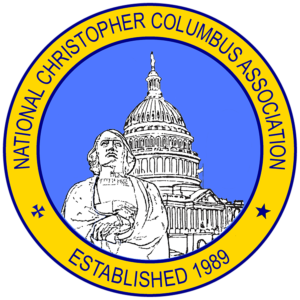By Dr. Edward M. Sullivan, Ph.D
New Year’s Day of 1503 found Christopher Columbus’s fourth and last expedition forced by weather to anchor in an extraordinary place. It was a bay almost precisely at what would a little over four hundred year later become the Atlantic end of the Panama Canal–that twentieth-century passage to the west which would be the man-made realization of what he had most laboriously been searching for in nature for a decade.
He was a little over half a year into his fourth and final voyage, an expedition that in 1503 centered on a place called Veragua that would give his heirs the title they bear to this day, and then ironically would come to an inglorious end at a place he had nine years earlier named Santa Gloria.
The First Expedition: Discovery of the Presumed Far East
Then about six weeks after his initial landfall an accident intervened: the grounding and loss on Christmas Eve, 1492 of his flagship, Santa Maria, off the northern coast of what is now Haiti in western Hispaniola. He established an outpost there (named La Navidad, because of the date). and, leaving there almost half of the 90 men who had set out with him, returned to Spain after an eventful return trip, arriving in March with triumphant news of his successful explorations. (Go to beginning of article.)
The Second Expedition: Colonization of Hispaniola and Search for the Mainland
That second venture focused primarily on Hispaniola, and on arrival the triumphalism quickly gave way to harsh reality. He found La Navidad in ruins, destroyed by Indians (apparently with some justice) and its colonists massacred. He now established a new settlement, Isabela, some miles to the east on that part of the coast that is now the Dominican Republic.
The main problems he encountered on this beautiful island were human difficulties–not only with the native inhabitants but perhaps especially among many of the Spanish adventurers, ill-suited to be colonists and resentful of these Columbus brothers (Italians! foreigners!) who led and governed them. Then, too, the organizational structure and functionaries that Spain had imposed on the Admiral/Viceroy on this colonization expedition made a rather more complicated situation than he had to contend with on the first voyage of discovery. These human problems were severely exacerbated by disease and privation due in large part to the poor siting of the new settlement, chosen originally for its proximity to reported gold mines.
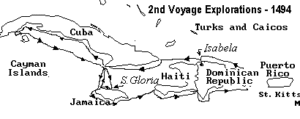 Ever the discoverer, Columbus for a while left–some would say “ran away from”–his gubernatorial duties and problems, placing them in the hands of his brother, Diego, a would-be priest who later became one, but apparently not the most suited to governing. However, Christopher trusted him, and headed west to explore for the first time the southern coast of Cuba, which he thought to be at its eastern end a peninsula of mainland China, and probably the mainland itself as one goes farther west, a notion he never gave up. When Indians on Cuba near present-day Santiago told him of an island to the south said to have gold, he later departed the Cuban coast to investigate, thus finding Jamaica. He landed and spent a night at present St. Ann’s Bay. which he named Santa Gloria “on account of the extreme beauty of its country.”1 It was a beauty spot he would sadly become only too familiar with nine years later.
Ever the discoverer, Columbus for a while left–some would say “ran away from”–his gubernatorial duties and problems, placing them in the hands of his brother, Diego, a would-be priest who later became one, but apparently not the most suited to governing. However, Christopher trusted him, and headed west to explore for the first time the southern coast of Cuba, which he thought to be at its eastern end a peninsula of mainland China, and probably the mainland itself as one goes farther west, a notion he never gave up. When Indians on Cuba near present-day Santiago told him of an island to the south said to have gold, he later departed the Cuban coast to investigate, thus finding Jamaica. He landed and spent a night at present St. Ann’s Bay. which he named Santa Gloria “on account of the extreme beauty of its country.”1 It was a beauty spot he would sadly become only too familiar with nine years later.
The Indians along this coast, noted for their huge dugout canoes (he measured one that was 96 feet long with an eight-foot beam) were more hostile than others he had recently encountered. At Santa Gloria 60 canoes came out and he cowed them with a blank cannon salvo. Sailing westward, he explored about a third of this northern coast (encountering another hostile Indian demonstration, in which his crossbow men killed a few Indians) before heading back north to continue his explorations. He then resumed sailing westward along the southern coast of Cuba to a point only about 50 miles from the western end of Cuba. But the coast turned southward at that point, and Columbus took this to be where the Malay Peninsula reached out from mainland China.2
Had he continued along the coast just a little more, he would have learned that Cuba is in fact an island rather than a peninsula. However, he again turned southward before heading back to Hispaniola, sailing around the western end of Jamaica and then eastward along its southern coast back toward Hispaniola. Reaching that island, he continued eastward along its southern coast for the first time, finally rounding the eastern end of Hispaniola to return to Isabela on the north shore from the opposite direction to that he had set out in five months earlier. He had completed the first circumnavigation by Europeans of larger islands in the New World–Jamaica and Hispaniola.
It was almost exactly a year after he had set out from Spain on this second voyage. He had suffered much illness in the five months’ excursion to Cuba and Jamaica and was now very sick–yet much cheered to find that his favorite brother, Bartholomew, had in the meantime been able to join the colonists in this New World. The sick Admiral appointed Bartholomew his deputy, and gave him a high title and rank (adelantado) that caused much resentment among the Spaniards.
It would still be about another year and a half before Christopher again returned to Spain, but the cumulative effect of his approximately two and a half years in the New World on this second expedition served to demonstrate his inadequacies as an administrator. He finally had to go back to Spain to patch things up at court, as well as deal with slanderous charges carried back by some former colonists. Diego had returned to Spain a year earlier and Bartholomew was left in charge on Hispaniola, with instructions to relocate the badly-sited Isabela settlement from the north to the south shore.
Christopher succeeded in fence-mending: his position was reaffirmed, and approval given for Bartholomew’s position and title and for another expedition. Almost two years after his return to Spain, the Admiral’s third voyage, of six vessels, set out.
The Third Expedition: Development of the Colony and Search for a Southern Continent
 In the second goal he was successful, first discovering the islands of Trinidad and then a portion of the neighboring mainland coast of Venezuela in South America, which he rightly concluded was indeed a continent (from the size of the river flow).
In the second goal he was successful, first discovering the islands of Trinidad and then a portion of the neighboring mainland coast of Venezuela in South America, which he rightly concluded was indeed a continent (from the size of the river flow).
But when he finally arrived at Hispaniola he found not only Bartholomew’s new city of Santo Domingo abuilding, but also a rebellion in progress led by the former chief justice of the colony, Francisco Roldán. Christopher adopted a conciliatory attitude toward the rebels only to find that damage to a couple of vessels in a storm prevented fulfillment of his commitments, and negotiations with the rebels dragged on for a year before a final settlement was reached.
Six weeks after arriving in Santo Domingo Christopher had sent a somewhat incoherent letter to the sovereigns reporting on the new continent and setting forth plans for Hispaniola, which lessened their confidence in him. Though he had more than once asked for an administrator of justice to help him govern, they appointed a man (Francisco de Bobadilla) whose personal disposition Columbus saw as the opposite of what was wanted. For Bobadilla apparently saw it as
But things moved slowly in those days: it took over a year before Bobadilla left Spain. In the interim there was yet another rebellion in the colony, led by one of Roldán’s lieutenants, Adrian de Moxica, and the Columbus brothers adopted more of a “get tough” policy, the evidence of which was two men hanging from the gallows when Bobadilla arrived. Like an avenging angel, he confiscated Christopher’s records and possessions and proceeded to sack and pack: sacking the three Columbus brothers and packing them off to Spain. Christopher voluntarily kept his chains on during the voyage until they could be removed by direct order of the sovereigns, and then kept them as a precious possession for the rest of his life.
The Fourth Expedition: Search for Valuable Products of the Earth and for a Western Passage between the Land Masses
He, in the meantime, had studied reports of those expeditions and noticed that they had been directed either north or south of the islands he had discovered–but no one had sailed farther to the west of them. This gave rise to a third aim that was not explicitly stated but understood by all: discovery of a passage west between the two land masses understood to lie to the south (the new continent) and to the north (the mainland of China, which Cuba was still believed to be a part of). Such a passage would make it possible to circumnavigate the globe.
Columbus set forth on May 9, 1502 with 140 hands, including his 13-year-old son Ferdinand and brother Bartholomew and an unusually high proportion of teenagers and very young men, in four vessels: La Capitana, Vizcaína, Santiago (also called Bermuda), and Gallega.
The fourth voyage can be viewed in three phases, focusing respectively on Hispaniola (lasting about a month in 1502), Central America (lasting about ten months in 1502-3), and Jamaica (lasting about a year in 1503-4).
Hispaniola
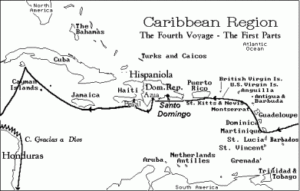 But the latter not only refused permission for him to put into Santo Domingo, but also ignored his weather warning and sent off the next day to Spain a large fleet of ships, carrying much gold, under the same captain (de Torres) who had commanded Columbus’s 17-ship armada his second voyage. They sailed directly into the hurricane, 19 of the 28 ships going down with all hands and 500 lives and a fortune in gold being lost–including DeTorres, the rebel Roldán and many of his men, and Bobadilla, who had sacked Columbus. Ironically, the only ship making it through to Spain was the one carrying Columbus’s own earnings from his interests on Hispaniola.
But the latter not only refused permission for him to put into Santo Domingo, but also ignored his weather warning and sent off the next day to Spain a large fleet of ships, carrying much gold, under the same captain (de Torres) who had commanded Columbus’s 17-ship armada his second voyage. They sailed directly into the hurricane, 19 of the 28 ships going down with all hands and 500 lives and a fortune in gold being lost–including DeTorres, the rebel Roldán and many of his men, and Bobadilla, who had sacked Columbus. Ironically, the only ship making it through to Spain was the one carrying Columbus’s own earnings from his interests on Hispaniola.
During the storm Columbus had sheltered his four vessels somewhat west of Santo Domingo. They suffered some damage, which he repaired and then headed westward into the second phase of fourth voyage. Sailing south of Jamaica, he retraced in a reverse direction the travel of nine years earlier. The vessels were then carried by currents northward toward Cuba, also not far from where he had been nine years earlier, whence they were finally able to sail southwest to hit Central America off the coast of Honduras.
Central America
Based on earlier misunderstood reports from Indians, Columbus had his hopes up that they were at the mouth to the long-sought passage to the west. It was almost ten years to the day after his initial discovery of the New World. What he had anticipated finding here was the Strait of Malacca, which in fact lies near Singapore, separating the Malay Peninsula from the Indonesian island of Sumatra. But those hopes were dashed when he learned instead that there is an impenetrable barrier between where he was and the western ocean of which the Indians had spoken.
He now concluded that his focus had to shift to making the voyage otherwise profitable to the sovereigns by finding the valuable commodities specified by his mission. Presumably, once he found an area worth exploiting, a more prolonged presence there would give an opportunity to pursue the other part of his mission–the conversion of the inhabitants.
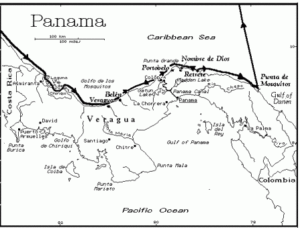 The coastline, in a concave curve, had shifted from north-south to northwest-southeast, and now began to run roughly in a west-east direction before curving more northward again He did hear of a source of gold farther along the coast in an area called Veragua by the Indians, and in short order arrived there. The Indians had some gold ornaments, but the area was not a very hospitable one (for one thing, there were no good anchorages), and after a stay of several days he proceeded further along the coast, interested in collecting samples of what might be available, in a kind of survey of what the prospects were. When after several days’ progress along the coast he concluded that those prospects had petered out, he decided to head back to Veragua again.
The coastline, in a concave curve, had shifted from north-south to northwest-southeast, and now began to run roughly in a west-east direction before curving more northward again He did hear of a source of gold farther along the coast in an area called Veragua by the Indians, and in short order arrived there. The Indians had some gold ornaments, but the area was not a very hospitable one (for one thing, there were no good anchorages), and after a stay of several days he proceeded further along the coast, interested in collecting samples of what might be available, in a kind of survey of what the prospects were. When after several days’ progress along the coast he concluded that those prospects had petered out, he decided to head back to Veragua again.
Again the weather turned against him. When the wind and currents were strong enough and there were no good anchorages or ports to put into, a sailing ship could not resist and could only A”o with the flow,” and his little fleet was forced eastward. About two months were lost due to the weather as his vessels were tossed back and forth along that coast by these uncontrollable forces, before finally getting back to Veragua. Sometimes they were able to shelter, perhaps for several days, in ports they found farther along the coast, only to have the wind turn against them when they ventured forth again. It was thus that Columbus ended up passing Christmas and New Year’s at what would just over 400 years later become the entrance to the Panama Canal that would provide the passage to the west he had sought but did not then exist.
Aside from discovering Central America (and of course claiming it for Spain) followed by exploring along the coast, the expedition had in fact accomplished very little in 1502 for all the hardships (and they were great) suffered from the weather–September through December, with October excepted. Perhaps the most significant result was a negative: the hugely disappointing conclusion that a westward passage through the land mass to the western waters could not be found.
The New Year: 1503
Veragua
Columbus first sent his boats up the river for trading, but the Indians here and up the Veragua were disinclined to trade. However, an Indian who had probably dealt with the Spaniards earlier at the lagoon gave them a favorable report on the Spaniards, and on January 12 Bartholomew then took the boats up the River Veragua.where they met a cacique named El Quibián, who gave permission for them to explore further, and visited and exchanged gifts with the Admiral on the Capitana the following day.
Suddenly on January 24 the rains in the mountains produced a flood, with consequent damage to Gallega, and the flooding, heavy rains, and rough seas breaking over the bar enforced a two-week hiatus in exploration, during which energies were turned to repair and maintenance on the ships.
By February 6 the sea was such that the ships’ boats could cross the bar again and Bartholomew took them to and up the River Veragua, where they spent the night with the Quibián and continued upriver the next day to the Indians’ gold mines, which indeed proved to be a good source of gold. Pleased with the report of the expedition, Columbus decided to make a settlement at the mouth of the River Belén with Bartholomew in charge, returning himself to Spain for men and supplies.
Then on February Bartholomew and 54 men rowed about another 20 miles west of the River Veragua, met a friendly reception from one cacique, then met another cacique, sent samples of gold disks they had bartered for back to the ships, and went on foot to another couple of villages where they collected a large number of such disks (which the Indians wore around their necks).
On their return, work began on the outpost, named Santa Maria de Belén. Gallega was to remain there, and contained the supplies from Spain. But the rain stopped when about a dozen structures had been built, the water level over the bar dropped to only two feet, and the ships were temporarily trapped in the estuary. Further, seeing that the Spaniards intended a permanent settlement, the Indians changed their hospitable attitude. Morison quotes Columbus: ” ‘They were very simple and our people very importunate,” and suggests that some of the Spaniards probably had been clandestinely extorting gold from neighboring Indians by force, as in fact had taken place several months earlier when the ships had sheltered for about a week and a half from the adverse weather to the east in a small harbor Columbus had named Retrete (“closet”).4
Decked out as for combat, some Indians appeared in the area, pretending they were joining a war party against Indians more to the west. Rightly suspicious, one of Columbus most faithful lieutenants, Diego Mendéz, (of whom more shortly) rowed toward Veragua and found an encampment of a thousand warriors. Columbus still wanted more confirmation of a threat to the settlement and so Mendéz (who had apparently been studying the language) with a single companion walked to the mouth of the Veragua and there encountered a couple of Indians and learned from them that an attack was planned for a couple of days later. The encampment had been moved to the Quibian’s village upriver, and Mendéz induced the pair to take him there. He gained access to the area of the cacique’s hut on the pretext that he had come to treat an arrow wound the cacique had sustained. Ignoring rude treatment and knowing of the Indians’ attraction to novelty, he there produced a barber’s kit (scissors, comb, and mirror) and in front of the Indians coolly received a haircut from his companion. Bemused, the Quibián then willingly had a trim, received the kit as a gift, and hosted a friendly meal.
But Mendéz returned to Columbus convinced that the Indians planned to wipe out the Spaniards. Columbus was convinced by him that the only solution was to capture the cacique. So with about 80 men, Bartholomew and Mendéz rowed up the River Veragua and hid most of the force in the vicinity of the Quibian’s village. With three men the two leaders went up and demanded to meet with the Quibián, who came out to find Mendéz showing concern for his wound, grasping him by the arm. A shot fired by one of the Spaniards at this point signaled the ambush party to rush out and capture the cacique and about 30 of his household, women and children among them, along with some gold booty. But that night as they were descending the river, the Quibián managed to escape, and rallied the Indians against the Spaniards.
Meanwhile, rain having raised the water level over the bar, three of the ships were towed out of the estuary, the intention being that Gallega would remain behind for Bartholomew, Mendéz, and the 70 men who were to stay at the settlement with them. On April 6, as they were saying their goodbyes, 400 Indians attacked the settlement with spears, slingshots, and bows and arrows, killing one Spaniard and wounding several, including Bartholomew, before being driven off after a three-hour battle, with the aid of the Spaniards’ Irish wolfhound, much feared by the Indians.
Offshore the Capitana’s captain with a boat party had put into the mouth of the Belén to go upriver and load up fresh water before leaving. They watched the battle and then continued on their mission, the captain confident they could take care of themselves when warned that the Indians might get them. A mile or so upstream they were ambushed from foliage-covered banks, the captain being killed by a spear through his eye and only one man escaping alive by swimming away underwater.
The boat, too, was destroyed, and there was only one left. and it was outside of the estuary with the three ships, Much as they might otherwise have decided to abandon the settlement at this point, they couldn’t get Gallega over the bar and Columbus could not risk sending his one remaining boat due to the shallowness of the water there, and of course there was still danger from the Indians.
It was during this fight that Columbus, sick and alone on Capitana, had a strange experience that may have been due to illness-induced delirium but which in his own view may have had a less mundane explanation.
After three days the Indians withdrew, but for another five days no boat could cross the bar. In the meantime, some of the captured Indians escaped from Santiago, where they had been imprisoned, and those who could not managed to hang themselves in the hold.
One man volunteered to swim in to learn the status of the settlement. He found the men at odds among themselves, vulnerable to another attack, and eager to abandon the outpost. When the Admiral approved, Mendéz made a raft of two dugouts and timbers and in seven trips over two days was able to carry all of the men and their supplies and gear over the bar, leaving behind the worm-eaten Gallega. The grateful Admiral appointed Mendéz to succeed the captain of Capitana who had been lost in the fresh water expedition. (Go to beginning of article.)
Exodus
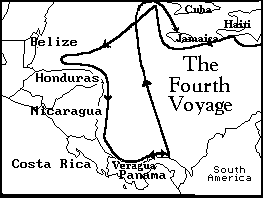 Within a week, on April 23 he had to abandon another vessel, Vizcaína, at Porto Bello, east of where he had anchored over New Year’s. Eight days later, on May 1, when 125 miles beyond Porto Bello the coast started dropping away to the south and points unknown, he gave in to the pilots and headed northward against his better judgment. The pilots mistakenly thought the ships were about 900 miles east of where they really were, which was due south of Jamaica, as Columbus realized.
Within a week, on April 23 he had to abandon another vessel, Vizcaína, at Porto Bello, east of where he had anchored over New Year’s. Eight days later, on May 1, when 125 miles beyond Porto Bello the coast started dropping away to the south and points unknown, he gave in to the pilots and headed northward against his better judgment. The pilots mistakenly thought the ships were about 900 miles east of where they really were, which was due south of Jamaica, as Columbus realized.
Leaving the Central and South American mainland for the last time they thus they moved from the second to the third phase of this fourth expedition. With his ships leaking due to the worm damage and requiring constant pumping, they sailed 700 miles north (and were also blown 90 miles west by the continuing wind), passing the Cayman Islands on May 10 and reaching Cuba two days later–making landfall in a large group of islands off the southern coast that, almost exactly nine years before on his second voyage, Columbus had named The Queen’s Garden. They lie just west of the point (Cabo de Cruz) Columbus used as the point of departure and return for his week-and-a-half excursion of discovery to Jamaica that earlier year.
Exhausted from constantly manning the pumps and hungry from the shortage of food, they anchored and then had to ride out a great storm that night which smashed one ship against the other, with considerable damage to both. Bad weather continued for about six days, and then in desperate straits they headed eastward along the Cuban coast. The situation on the vessels was getting worse daily. “Of all melancholy work on shipboard, pumping a hopelessly leaky vessel is the worst; the labor is back-breaking, there is no respite, and you know it can never improve,”6 observes Morison.
Jamaica
The redoubtable Mendéz was eminently successful, making arrangements for food in exchange for trading items (which the Spaniards still had) with a couple of villages and then with a great cacique. At the eastern of the island he even entered into a close friendship with another cacique, from whom he bought a dugout canoe, in which, with six Indian paddlers, he returned triumphantly to Santa Gloria loaded with provisions. Noting that those on the beached ships were then completely out of food and starving. Morison wonderingly comments, “I cannot understand why they were unable to catch fish, or to buy maize and cassava from the nearby village of Maima. However, Indians from near and far now came daily with food supplies, and for several months the question ‘when do we eat?’ did not arise.”8
But how to get home? Captains of that time, unlike later ones, didn’t carry the tools needed for felling trees and shipbuilding, and the expedition’s two caulkers had fallen at Belén. The sole remaining boat had been lost in the storm in the Queen’s Garden, no ship had visited Jamaica in the last nine years, and none could be expected. Columbus would have to send a dugout to Hispaniola to seek help–105 miles across open water from the east end of Jamaica to that island in the face of contrary winds and current, and then another 350 miles to Santo Domingo. When it was put to all of the officers, Diego Mendéz was the only one to volunteer. Columbus knew matters couldn’t wait, for the Indians might at any time turn against him, or he might lose control over his men in this unhappy situation. They do not seem to have been the most reliable lot.
Mendéz added a mast and sail and other modifications to the canoe he had bought, selected another man and six Indian paddlers, and set out around July 7, carrying a letter of that date from Columbus to the sovereigns, known today as the Lettera Rarissima. Near what he believed to be the eastern end of the island, when he walked alone into a forest he found himself suddenly surrounded by a party of Indians. While they were gambling to see who would kill him, he was able to escape, return to the canoe, and head back to Santa Gloria.
At Columbus’s request, Mendéz agreed to try again, if accompanied by an armed escort to the jumping-off point on the east end of the island. This time there would also be a second canoe, commanded by the Genoese former captain of the abandoned Vizcaína, Bartholomew Fieschi. Each would take six Spaniards and ten Indians, and the two canoes would be accompanied to land’s end by Bartholomew and a sizable force in a number of dugouts. All this seems to have been arranged with considerable and surprising dispatch, for they set out only about ten days after Mendéz had set out on the ill-fated first attempt.
If both got through, Fieschi was to return to let Columbus know help would be on its way, while Mendéz was to continue on to Santo Domingo and contract for a rescue vessel. But Columbus and his men marooned at Santa Gloria heard nothing. Weeks passed, and then months, and no Fieschi. There was considerable discontent. particularly with the enforced restriction on “liberty” or “shore leave” from the beached ships, and two political appointees, the Porras brothers, hatched rebellion.
Francisco Porras, though captain of the Santiago, knew little of seamanship, and Bartholomew Columbus filled that role on a de facto basis, while Diego Porras, comptroller and crown representative, was an idler whose only work on the voyage had been to keep track of the relatively little gold brought aboard. Taking advantage of the growing discontent, they convinced about half of the men to join in their plot.
The date set for action was January 2, 1504, when, as it happened, the Admiral was laid low with arthritis.
Thus ended the dismal, disappointing year 1503. The new year, 1504, was to come. And so, obviously, were more trials for Columbus.
